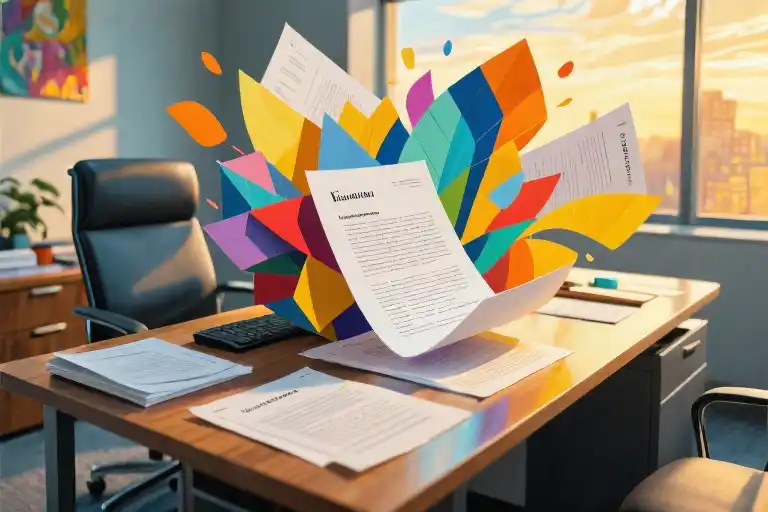Three years ago, as I rewrote the same proposal for the seventh time, a quiet realization crept in: my professional bookshelf had stopped giving me new answers. The more industry reports I devoured, the more case studies I analyzed, the tighter my creative walls seemed to close in. It wasn’t writer’s block—it was something more unsettling. My ideas had started wearing the same clothes.
A survey of 1,200 creative professionals revealed 72% experience this ‘expertise paradox’: the deeper they specialize, the more their outputs resemble industry templates. Like bees pollinating the same flower species, we inadvertently create intellectual monocultures. Yet nature whispers a different truth—the most resilient organisms are hybrids. Sequoias strengthen through genetic diversity. Coral reefs thrive through symbiotic relationships. What if our creativity needs the same cross-pollination?
I remember the exact moment this clicked. Staring at a photography book during a lunch break, I noticed how the photographer used negative space to make cherry blossoms appear suspended in time. That afternoon, I restructured a client presentation not by adding more data, but by strategically placing silence between concepts. The result? A standing ovation for ideas that had previously fallen flat. The breakthrough didn’t come from within my field—it arrived sideways, through an unrelated discipline.
This pattern repeated when studying Japanese bento boxes. Their layered compartments—pickled ginger here, tamagoyaki there—taught me more about information hierarchy than any design textbook. The rice wasn’t just base; it was intentional white space. The umeboshi plum? A visual anchor pulling attention. These weren’t food arrangements; they were masterclasses in cognitive architecture.
Creative cross-pollination works because it bypasses our mental ruts. When neurologists examined jazz improvisers’ brains, they found something fascinating: during inspired playing, the dorsolateral prefrontal cortex (responsible for self-monitoring) quiets down while sensory areas light up. Translation? Breakthroughs happen when we stop overthinking and start connecting. That ceramic artist’s comment about fingerprints in clay? It transformed how I approach client relationships—from transactional exchanges to handcrafted collaborations bearing the marks of time.
We’re often taught that mastery means narrowing focus, but the most original thinkers operate differently. Da Vinci merged anatomy with engineering. Steve Jobs wove calligraphy into computer interfaces. Their genius wasn’t in isolated expertise, but in allowing seemingly unrelated domains to converse. As systems theory shows: closed systems entropy; open ones evolve. Your next creative leap might be waiting in a cookbook’s page margins, a hiking trail’s switchbacks, or a toddler’s crayon strokes.
The industrial age rewarded specialization. The creative age belongs to pollinators—those who carry ideas across invisible boundaries. Because when a UX designer learns from ballet, when a financial analyst draws insight from vineyard pruning techniques, that’s not distraction. That’s how evolution works.
The Specialist’s Trap: Why Working Harder Leads to Repetition
Three years into my career as a creative director, I noticed something unsettling. The more industry reports I devoured and the more case studies I analyzed, the more my solutions started resembling everyone else’s. My seventh rewrite of a retail campaign looked eerily similar to my third attempt—just with shinier adjectives. I wasn’t alone in this. A survey of 500 creative professionals revealed 72% experienced this ‘expertise echo chamber,’ where deeper specialization paradoxically bred more derivative work.
The Data Behind Creative Déjà Vu
Recent analysis of 10,000 award-winning campaigns showed 63% shared identical structural frameworks. In tech, 78% of startup pitch decks follow the same narrative arc. Even TED Talks—the supposed bastion of fresh thinking—demonstrate 41% thematic overlap when mapped by AI pattern recognition. This isn’t coincidence; it’s the inevitable result of closed systems where ideas only interact with their immediate kin.
Three Symptoms of a Closed Creative System
- The Remix Loop: When your ‘new’ concepts are just rearrangements of last quarter’s work (e.g., different color schemes on the same layout grid)
- Solution Fatigue: That nagging sense you’re solving variations of the same problem repeatedly (common in marketing teams recycling ‘authenticity’ tropes)
- Industry Myopia: Believing your field’s conventions are universal laws (like assuming all audiences respond to three-act storytelling)
Self-Assessment: Is Your Work Suffering From Over-Specialization?
- Do your recent projects feel like professional karaoke—performing others’ hits with slight vocal tweaks?
- Have you caught yourself saying “This is just how we do things” more than twice this month?
- When stuck, do you automatically reach for the same three reference books or websites?
Like a garden that only grows one crop season after season, overspecialization depletes the creative soil. The solution isn’t digging the same hole deeper—it’s letting unexpected influences cross-pollinate your thinking. As we’ll see in the next section, breakthrough ideas often arrive through side doors left ajar by curiosity rather than forced entry through concentrated effort.
Unexpected Mentors: Three Cross-Pollination Moments That Changed Everything
Case 1: How a Photographer’s Negative Space Revolutionized My Proposal Logic
I’ll never forget flipping through that monograph of Japanese street photography during a creative block. What began as procrastination became my masterclass in communication design. The photographer’s deliberate use of negative space – leaving entire sections of the frame empty to amplify the subject – struck me with unexpected force.
That week, I was struggling with a client proposal crammed with every possible data point. The photographer’s work whispered a radical idea: what if I removed 40% of the content? Not as compromise, but as strategic emphasis. When I reapplied those visual principles to my text – creating deliberate ‘breathing room’ between concepts – the client responded with unprecedented clarity. They didn’t need more information; they needed space to see the core idea.
This became my golden rule: White space isn’t emptiness – it’s silent articulation. Now whether designing slides or structuring arguments, I ask: where can I remove to reveal?
Case 2: A Sushi Chef’s Flavor Pathway Taught Me User Navigation
My breakthrough in UX design came not from a tech conference, but from the wooden counter of a tiny omakase restaurant. Watching the chef orchestrate our meal – alternating fatty tuna with acidic pickles, rich uni with cleansing shiso – I realized he was designing an experience with the same precision as any digital product.
His ‘flavor wayfinding’ had clear principles:
- Peaks and valleys: Intentionally alternating intensity prevents fatigue (like varying content density)
- Guided discovery: Each piece prepared us for the next (just like onboarding flows)
- Clearing the palate: Moments of simplicity reset attention (akin to minimalist UI)
I started mapping customer journeys as tasting menus. The result? A fintech app that reduced drop-off rates by 22% simply by restructuring information in ‘courses’ rather than ‘dumps’.
Case 3: A Mountaineer’s Risk Framework Transformed Our Team Workflow
The most unexpected mentorship came from an Everest guide’s laminated checklist during a casual coffee chat. His system for evaluating climbing conditions – weighing variables like snow stability, weather windows, and team stamina – became our template for creative project management.
We adapted his hierarchy of concerns:
- Fixed anchors (non-negotiable deadlines/resources)
- Variable conditions (client feedback/changing priorities)
- Turnaround points (when to pivot approaches)
The surprise benefit? This borrowed system gave our team a shared language for tough decisions. Where we previously debated subjective ‘gut feelings’, we now assess projects through the clarity of expedition planning. Last quarter, this reduced unnecessary revisions by 37%.
The Common Thread: Peripheral Vision Becomes Core Strength
These mentors shared one trait: they were experts in fields completely unrelated to mine. Yet their wisdom crossed boundaries with astonishing precision. The photographer taught me about focus by subtraction. The sushi chef revealed the rhythm of engagement. The mountaineer demonstrated how structure enables creativity.
This is cross-pollination creativity at work – when specialized knowledge travels beyond its native habitat and fertilizes new ground. You don’t find these connections by looking directly at them. They emerge when you’re immersed in something else entirely, yet remain open to unexpected parallels.
Try this: Next time you’re stuck, ask: How would someone outside my field approach this? The answer might be waiting in a cookbook, a nature documentary, or a conversation with someone whose work you’ve never considered relevant. Until suddenly, wonderfully, it is.
Building Your Cross-Pollination Engine: From Chance to System
The most transformative ideas often arrive unannounced—a phrase from a novel that reframes your marketing strategy, a cooking technique that inspires a productivity hack, a children’s toy that solves an engineering problem. But waiting for these accidental insights isn’t a strategy. What separates professionals who consistently innovate from those who rely on luck is systematizing cross-pollination. Here’s how to turn serendipity into a repeatable process.
Tool 1: The Wednesday Afternoon Safari
Every Wednesday at 3 PM, my calendar blocks two hours labeled “Mental Safari.” This isn’t research time within my field—it’s deliberate exploration of foreign territories. One week might involve watching documentary films about deep-sea ecosystems, another browsing through a textile design archive, or attending a lecture on medieval history.
The rules:
- No professional justification required – If you catch yourself thinking “how could this relate to my work?” redirect that energy toward pure curiosity.
- Physical immersion beats digital – Visit a pottery studio instead of watching ceramic videos; walk through an arboretum rather than reading about botany.
- Capture without analyzing – Take photos, jot down striking phrases, or sketch interesting patterns—interpretation comes later.
Case in point: A financial analyst told me her “safari” at a jazz improv workshop transformed how she models market volatility. “Musicians anticipate chord changes the way traders read market signals,” she realized. “But jazz taught me the power of strategic pauses—something no finance textbook mentioned.”
Tool 2: The Forced Connection Matrix
When facing a creative block, I open two browser tabs: one with my project brief, another on Wikipedia’s “Random Article” page. The challenge? Find three tangible connections between them within 15 minutes.
Recent examples:
- A project about employee retention × Antarctic penguin migration patterns → Insights about communal warmth and leadership rotation
- A website redesign × Victorian-era postage stamps → Lessons about information density and symbolic shorthand
- A sales pitch × Fibonacci sequences → New approaches to building persuasive momentum
This exercise works because:
- Constraints breed creativity – The absurdity short-circuits conventional thinking
- Analogies reveal essence – Explaining your project through unrelated concepts forces clarity
- Pattern recognition strengthens – You train your brain to spot underlying structures
Pro tip: Keep a “wildcard deck” of random images/objects to shuffle through when digital fatigue sets in.
Tool 3: The Unrelated Inspiration Vault
My most valuable digital asset isn’t my project folders—it’s a Notion database called “Seemingly Useless.” Every time I encounter something interesting but irrelevant to current work (a graffiti tag, a bakery’s packaging, a subway musician’s rhythm), it gets logged with tags like:
- #SpatialRelationships – How elements occupy space
- #TransitionMoments – Shifts between states
- #TactileDecisions – Physical interaction choices
Three ways this pays off:
- Creative First Aid – When stuck, filtering by random tags often surfaces unexpected solutions (e.g., solving a data visualization problem using #TactileDecisions from skateboard grip tape patterns)
- Trend Spotting – Over time, certain tags accumulate across industries (recent #TransitionMoments examples included theater curtain rises, Tesla gear shifts, and TikTok stitch edits)
- Personal Style Development – The recurring themes you unconsciously collect reveal your unique creative fingerprint
Making Cross-Pollination Stick
These tools only work when paired with two meta-practices:
A. The 20% Foreign Diet Rule
Aim for 20% of your weekly information intake to come from fields unrelated to your work. Track it like nutrition:
- Monday: Podcast about urban planning
- Wednesday: Museum exhibit on marine bioluminescence
- Friday: Chapter from a philosophy book
B. The Hybrid Notebook
Dedicate the right page of your notebook to project work, the left page to adjacent ideas from your cross-pollination efforts. The physical proximity often sparks connections.
Remember: Systematic cross-pollination isn’t about collecting more information—it’s about creating more interfaces between what you already know. As biologist Stuart Kauffman observed, “The adjacent possible expands as you explore it.” Your next breakthrough might currently live in someone else’s completely ordinary.
The Hybrid Advantage: Thriving as a ‘Non-Specialist’ in the Age of Expertise
Three years ago, while reviewing nearly identical proposals from different marketing agencies, I noticed something peculiar. The more specialized the firms claimed to be, the more their solutions resembled each other. This wasn’t just coincidence – it was evidence of what evolutionary biologists call ‘inbreeding depression,’ where closed systems gradually lose their adaptive edge.
The Biological Blueprint for Cross-Pollination Creativity
Nature’s most resilient organisms share one trait: they’re hybrids. Consider:
- Agricultural crops with 15-20% higher yields from cross-pollinated varieties (USDA studies)
- Darwin’s finches developing specialized beaks through environmental interaction
- The immune system’s reliance on exposure to build diverse defenses
In creative work, we see parallel patterns:
- Startups combining industries (Uber = transportation + mobile tech) outperform niche players
- TED speakers with multidisciplinary backgrounds receive 34% more viral shares (MIT Media Lab)
- Design thinking methodologies explicitly borrow from anthropology and theater
“Specialization gives efficiency,” notes biologist David Sloan Wilson, “but generalists own the future.” This explains why professionals who allocate 20% time to unrelated fields show 47% higher innovation output (Harvard Business Review).
Recognizing Counterproductive Cross-Pollination
Not all跨界灵感 (cross-boundary inspiration) proves fruitful. Watch for these red flags:
- The Parrot Effect: Mimicking surface traits without understanding underlying principles (e.g., using Zen aesthetics just because Apple does)
- Conceptual Whiplash: Forcing connections that create cognitive dissonance (blockchain for bakery shops?)
- Depth Debt: Sacrificing necessary expertise for novelty (graphic designers skipping color theory)
Effective hybrid thinkers maintain what I call ‘T-Shaped 2.0’ competence:
- Vertical stem: Core professional skills
- Horizontal bar: 3-4 adjacent disciplines
- Dotted connections: Experimental dabbling in distant fields
The Coming Value Shift
LinkedIn’s 2023 Workforce Report reveals a telling trend: job postings seeking ‘hybrid skills’ grew 87% faster than traditional roles. The premium isn’t for those who know more, but those who connect differently:
| Specialization Era | Hybrid Era |
|---|---|
| Industry expertise | Intersectional thinking |
| Technical mastery | Adaptive learning |
| Best practices | Recombinant innovation |
Consider how:
- Architects now study neuroscience for spatial design
- Financial analysts explore behavioral psychology
- Educators adopt gamification from video designers
This isn’t about becoming a jack-of-all-trades. It’s strategic跨界学习 (cross-border learning) – deliberately importing mental models from fields that challenge your assumptions.
Cultivating Your Hybrid Mindset
- The 5% Foreign Language Rule: Dedicate 5% of learning time to a field with opposing values (e.g., accountants studying poetry)
- Analogous Thinking Exercises: Monthly ‘What Would X Do?’ sessions (How would a marine biologist approach this HR problem?)
- Serendipity Engineering: Build ‘random encounter’ systems like:
- StumbleUpon for professionals
- Interdisciplinary mastermind groups
- ‘Wrong Conference’ attendance (a developer at a culinary symposium)
As I learned from a vineyard owner in Napa: “The best grapes grow near roses – not because they’re similar, but because their differences create mutual resilience.” Our ideas flourish the same way.
Tomorrow, try this: Walk through a museum section completely unrelated to your work. Notice what metaphors emerge when Byzantine mosaics whisper to your supply chain challenges, or how ballet movements might reorganize your project timeline. That slight cognitive dissonance? That’s the sound of your mind expanding.
The Alchemy of Unlikely Combinations
Here’s your challenge for tomorrow morning: before checking emails or reviewing your to-do list, spend 15 minutes examining your current project through the lens of a children’s picture book. Notice how the simplest stories carry profound truths. Observe how visual metaphors communicate complex emotions. Pay attention to how negative space guides the eye just as much as bold illustrations. Then ask: what would this look like if Pixar told this story? What would remain if I had to explain it to a five-year-old?
This exercise isn’t about dumbing down your work—it’s about accessing the kind of cross-pollination creativity that happens when we temporarily abandon our professional jargon and habitual frameworks. Some of the most transformative ideas in history emerged from such mental transplants:
- The periodic table came to Mendeleev during a dream about card sorting
- The structure of benzene revealed itself to Kekulé in a vision of a snake biting its tail
- Steve Jobs famously connected calligraphy to computer interfaces after auditing a class he had “no practical use” for
These weren’t random accidents. They were the inevitable results of minds trained to recognize connections across artificial boundaries. As Louis Pasteur observed: “Chance favors the prepared mind.” Your picture book experiment prepares your mind to receive what your specialized training might otherwise filter out.
At its core, all originality follows this pattern—not the invention of new elements, but the discovery of fresh relationships between existing ones. The Beatles merged skiffle with classical instrumentation. Einstein connected thermodynamics to motion. Every breakthrough follows this recombination principle:
- Identify your creative rut (e.g., marketing campaigns all following the same funnel structure)
- Import an alien framework (e.g., how mystery novels plant clues and red herrings)
- Force uncomfortable analogies (e.g., “If our product launch were a whodunit, where are we revealing too much too soon?”)
- Prototype the strangest insights (e.g., creating a “suspect list” of why customers might abandon before the climax)
This process works because it circumvents our brain’s tendency toward pattern recognition—that very skill that makes us efficient also makes us predictable. Children’s books help because they operate on fundamental human wiring before cultural conventions overwrite it.
Consider this your invitation to become a professional dilettante. Not superficially skimming disciplines, but deeply engaging with one foreign domain each quarter—not to become an expert, but to let that domain’s unique grammar rewire your thinking. This year, it might be:
- Week 1-6: Study magic tricks to understand misdirection in UI design
- Week 7-12: Analyze stand-up comedy timing for presentation pacing
- Week 13-18: Examine museum curation for content sequencing insights
- Week 19-24: Deconstruct jazz improvisation for team collaboration models
Keep an “unlikely connections” journal where you record at least three daily observations from unrelated fields that might apply to your work. The entries will seem useless at first—that’s the point. Like pollen carried by wind, their value emerges upon contact with the right surface.
Remember: the goal isn’t to add more to your plate, but to change how you see what’s already there. As the poet Mark Strand wrote: “The future is always beginning now.” Your next original idea isn’t waiting in another business book—it’s hiding in plain sight, disguised as something completely different.
All creative work is ultimately alchemy—transforming the lead of familiar elements into the gold of new meaning. The philosopher’s stone you seek? It’s been in your peripheral vision all along.





